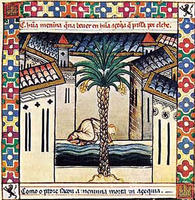You are in: Europe -> Spain -> Palmeral of Elche, and traditional search or Image Gallery will yield results of this site only
Palmeral of Elche
| Site number: | 930 |
|
| Type of site: | Cultural | |
| Date: | 10th century | |
| Date of Inscription: | 2000 | |
| Location: | Europe, Spain, Province of Alicante, Autonomous Community of Valencia | |
Up to 75 images are shown here. Click on each for more details or on Image Gallery for more images.
| Description: | The Palmeral of Elche is a setting of date palm groves; its intricate irrigation systems were formally laid out, at the time the Muslim city of Elche was founded, at the end of the 10th century A.D., when a great deal of the Iberian peninsula was Arab. The Palmeral is a sanctuary, a system fit for agrarian production in waterless areas. In addition, it is a unique example of Arab agricultural practices within a European context. The site has had date palm cultivation since at least the Iberian times, dating around the 5th century B.C. --WHMNet paraphrase from the description at WHC Site, where additional information is available. | |
| The Palmeral of Elche (Spanish: Palmeral de Elche, Valencian: Palmerar d'Elx) is a plantation of palm trees in the Spanish province of Alicante. It is the largest palm grove (Spanish: palmeral) in Europe and one of the largest in the world, surpassed in size only by some in Arab countries. The Palmeral includes the Parque Municipal and many other orchards (huertos), covering over 3.5 square kilometres, including 1.5 km² within the city of Elche (Elx). It contains more than 11,000 palm trees, mostly date palms, with individual specimens up to 300 years old. At its peak, in the 18th century, it may have covered an area twice as large, with up to 200,000 trees. The dates are harvested in December. The largest palm is the "Imperial Palm" (Palmera Imperial), with 7 stems in the shape of a candelabra, named after Elisabeth, known as Sissi, the Empress consort of Franz Joseph, who visited the plantation in 1894. It is thought that palms were originally planted in this location as early as the 5th century BC by Carthaginians who settled in south-east Spain. The plantation survived under the Romans and the Moors. The irrigation system was extended in the times of Abd ar-Rahman I and remains in use. The formal landscape of the palmeral that still exists today was created when the city was under Moorish control in the 10th century. Although the area has an annual rainfall of only 300 mm, the palm trees planted along a network of irrigation canals from the salty River Vinalopó creates a patchwork of agricultral plots (huertos), each demarcated and shaded by the palm trees to create a protected microclimate. Laws were passed to protect the plantation after the Reconquista. In 2005, it was discovered that the larvae of the red palm weevil (Rhynchophorus ferrugineus) had infested some trees, laying its eggs inside the stems. --Wikipedia. Text is available under the Creative Commons Attribution-ShareAlike License. | ||
| Source: | http://whc.unesco.org/en/list/930 | |
| Reference: | 1. UNESCO World Heritage Center, Site Page. | |
















